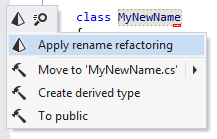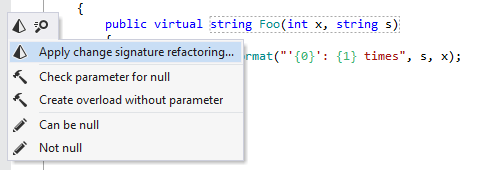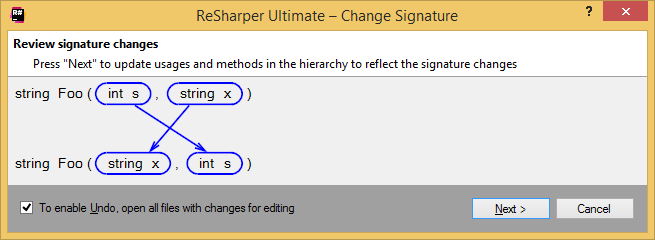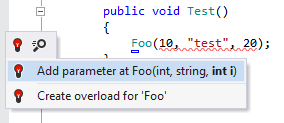Inplace refactorings
Some of the refactorings can be applied without invoking any commands — it is enough to modify your code in the editor. If ReSharper detects that your modification could be an intention to refactor the code, a grey border appears around the modified code and the corresponding action indicator ![]() appears on the left. You can use this action to apply the refactoring solution-wide.
appears on the left. You can use this action to apply the refactoring solution-wide.
The following refactorings are available in-place:
Rename
You can rename an entity by modifying its declaration right in the editor and then applying a quick-fix to invoke the solution-wide refactoring.
As soon as you change entity's name at its declaration, a grey border appears around the name, notifying you that the refactoring is available. You can press Alt+Enter to find the refactoring in the action list:

For more information about the refactoring, refer to Rename refactoring.
Change signature
You can change function's signature by modifying its declaration right in the editor and then applying a quick-fix to invoke the solution-wide refactoring.
For instance, if you reorder parameters in a method, a grey border appears around the method signature, notifying you that the refactoring is available. You can press Alt+Enter to find the refactoring in the action list:

After applying the quick-fix, a dialog shows your changes to the method signature:

You can click Next to apply the change solution-wide.
You can also apply the Change Signature refactoring when you add one new argument in any of the function's calls. In this case, ReSharper detects the incorrect call, highlights it and suggests the corresponding quick-fix:

This quick-fix will invoke the refactoring and update the declaration of the function and all its usages solution-wide. If necessary, ReSharper will display a call diagram to pick values for each specific call individually
For more information about the refactoring, refer to Change Signature refactoring.
Move nested class or static member
You can apply the refactoring by cutting a nested type or a static member and pasting it into another type. As soon as you paste the item, a grey border appears around it and a popup is shown, notifying you that the refactoring is available. You can click the suggestion or press Alt+Enter to invoke the solution-wide refactoring:

For more information about the refactoring, refer to Move to Another Type refactoring.